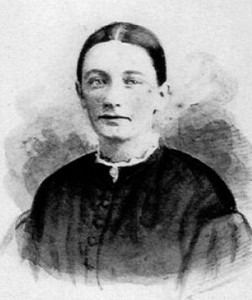Cornelia Hancock

Cornelia Hancock was a 23 year old Quaker girl from Salem, NJ who after hearing the news of the terrible battle at Gettysburg determined to go to the soldiers. The 12th New Jersey Regiment to which many neighbors and relatives enlisted was brigaded with the 14th Connecticut. She got her brother-in-law a prominent Philadelphia doctor who was going to aid the soldiers at Gettysburg to agree she could come along with him to nurse. When she and her female chaperone met Dorthea Dix at the train station in Baltimore organizing relief, Dix objected to Cornelia because she was young, beautiful, and had “rosy cheeks”. Dix desperate for nurses accepted every female volunteer but Cornelia, rejecting her out of hand and refusing to allow her to proceed to the Battlefield. While her capable chaperone and Dix argued away about her, Cornelia quietly boarded the train to Gettysburg as it pulled out of the station. She arrived at the battlefield on July 6, 1863, three days after the battle ended and became a legend to the soldiers of the Second Corps throughout the war for her capable and dedicated ministrations to the men. Unlike Clara Barton and other well-known women nurses, she never published or sought notoriety, but was as well-known as they were throughout the Army and perhaps more so. Often she was the only woman allowed in the areas where she nursed. She never associated herself officially with any formal organization, but every commission supported her and saw to it she was supplied with whatever supplies she requested for the soldiers. Her requests to the Army for supplies were also honored without question.

The Battle of Gettysburg, by James Walker
Upon her arrival at Gettysburg, Cornelia immediately went to work at the 2nd Army Corps hospital at the Jacob Schwartz Farm. She was the first woman to enter this hospital. During the evenings she stayed at Dr. Horner’s residence on the north side of Chambersburg Street diagonally across from the Lutheran Church from July 6 through September, when she moved her lodging to Camp Letterman. On July 7, 1863 she wrote home to a cousin, “there are no words in the English language to express the sufferings I witnessed today.” She would witness so many more sufferings before the war had ended and always met them head on doing all she could and what was best for her soldiers.
She lived to 87 and never married. She lived her life to the fullest. She was involved in numerous successful charities until her death and was very well known in Victorian America for her accomplishments in helping others. She may perhaps have been one of the first social workers in the United States. She dedicated her life to service of others. During the Civil War she was one of the most selfless and dedicated volunteer nurses to the men of the Army of the Potomac.
Sources
Coco, Gregory, A., A Vast Sea of Misery, A History and Guide to the Union and Confederate Field Hospitals of Gettysburg, July 1-November 30, 1963, Thomas Publications, Gettysburg, PA 1988
Jaquette, Henrietta, Stratton, editor, Letters of a Civil War Nurse, Cornelia Hancock, 1863-1865, University of Nebraska Press, 1998. Buy Here
U.S. Census data from Ancestory.com: http://www.ancestry.com/
The American Civil War Research Database, Soldier History, Frederick A. Dudley: http://www.civilwardata.com/active/hdsquery.dll?SoldierHistory?U&275641
History of the Fourteenth Regiment, Connecticut Vol. Infantry – Charles Davis Page, Google Books, http://books.google.com/ebooks/reader?id=rwY0RR_tT0sC&printsec=frontcover&output=reader
New Jersey in the Civil War: http://www.njcivilwar150.org/cwenj.asp
About the Author
Carolyn Ivanoff is an assistant principal at Shelton Intermediate School in Shelton Connecticut. She has over twenty years of experience in a variety of educational settings in public schools: teacher, administrator, departmental chair, teacher leader, adult educator and software trainer. A version of this post was originally published on her website.
Tags: Cornelia Hancock, Dix Nurse, Dorothea Dix, Gettysburg, Nurse, Women's History, Women's History Wednesday Posted in: Uncategorized
